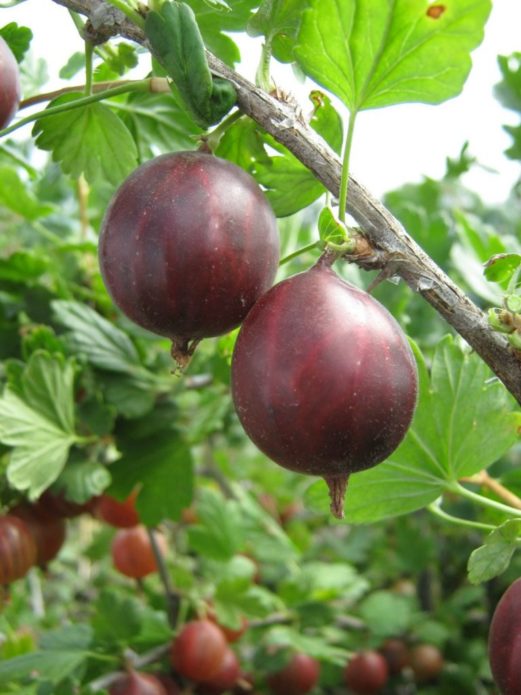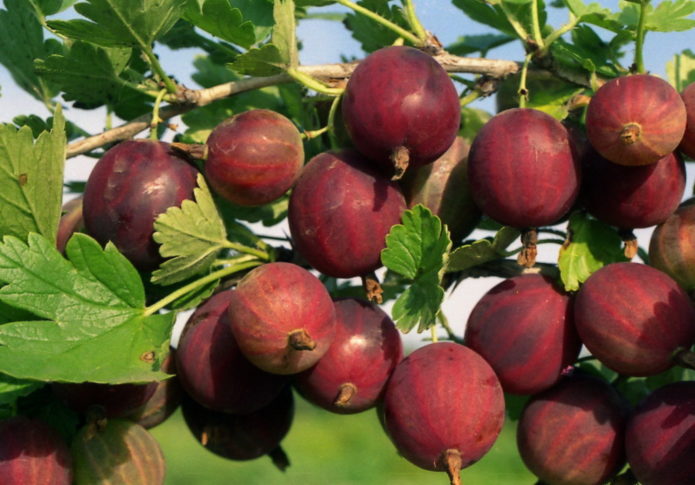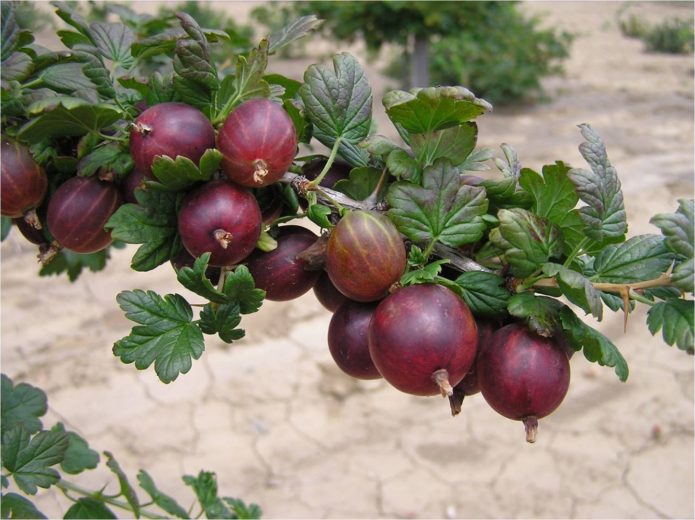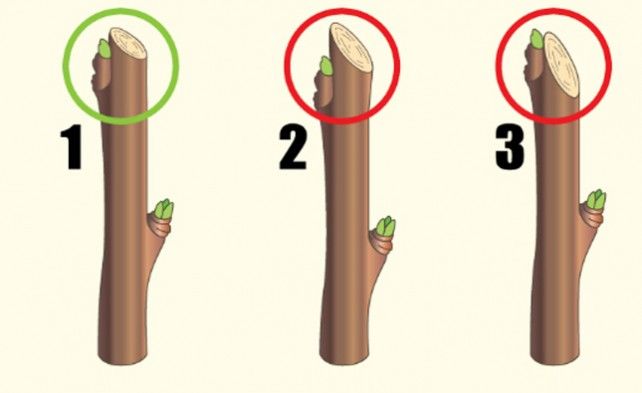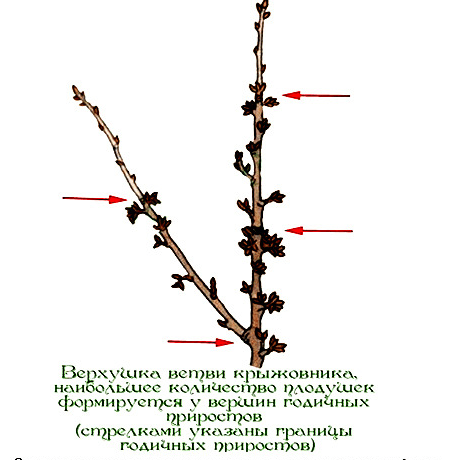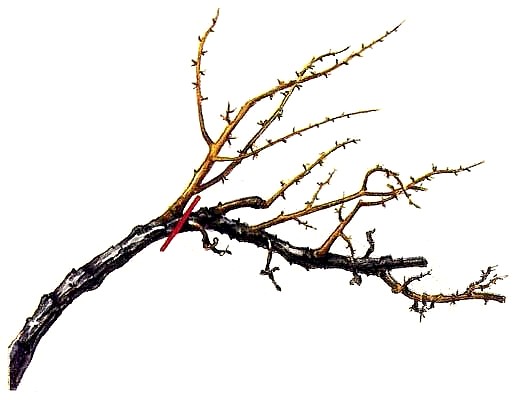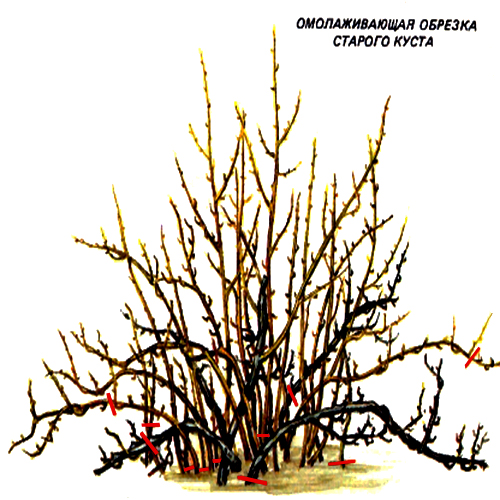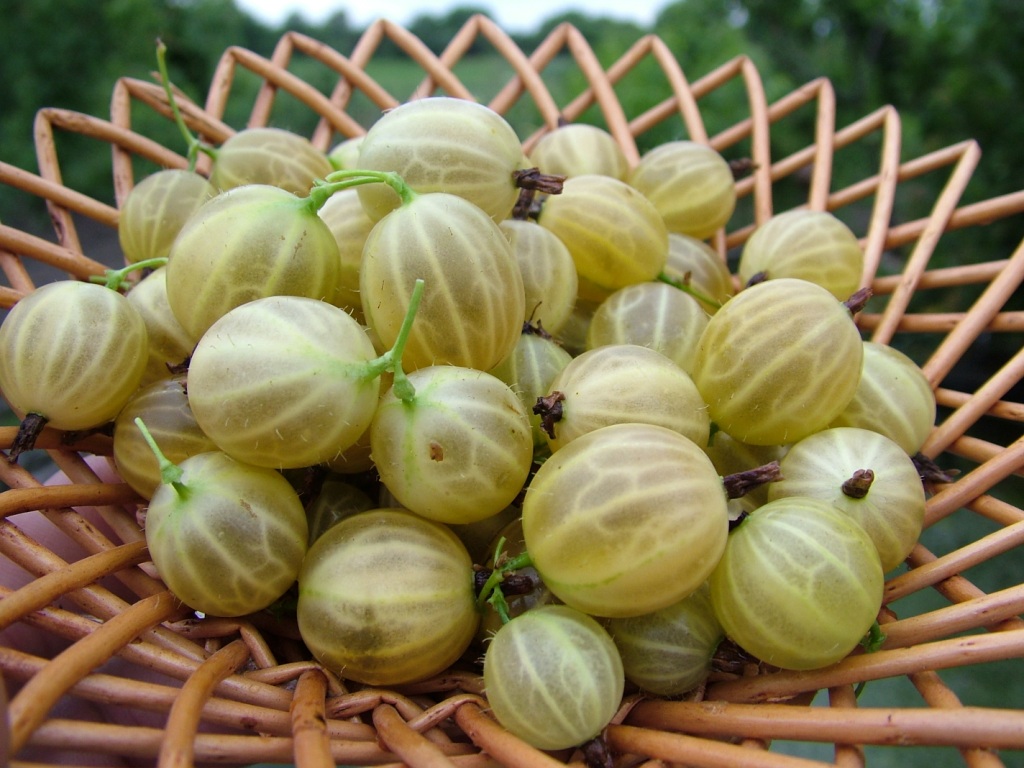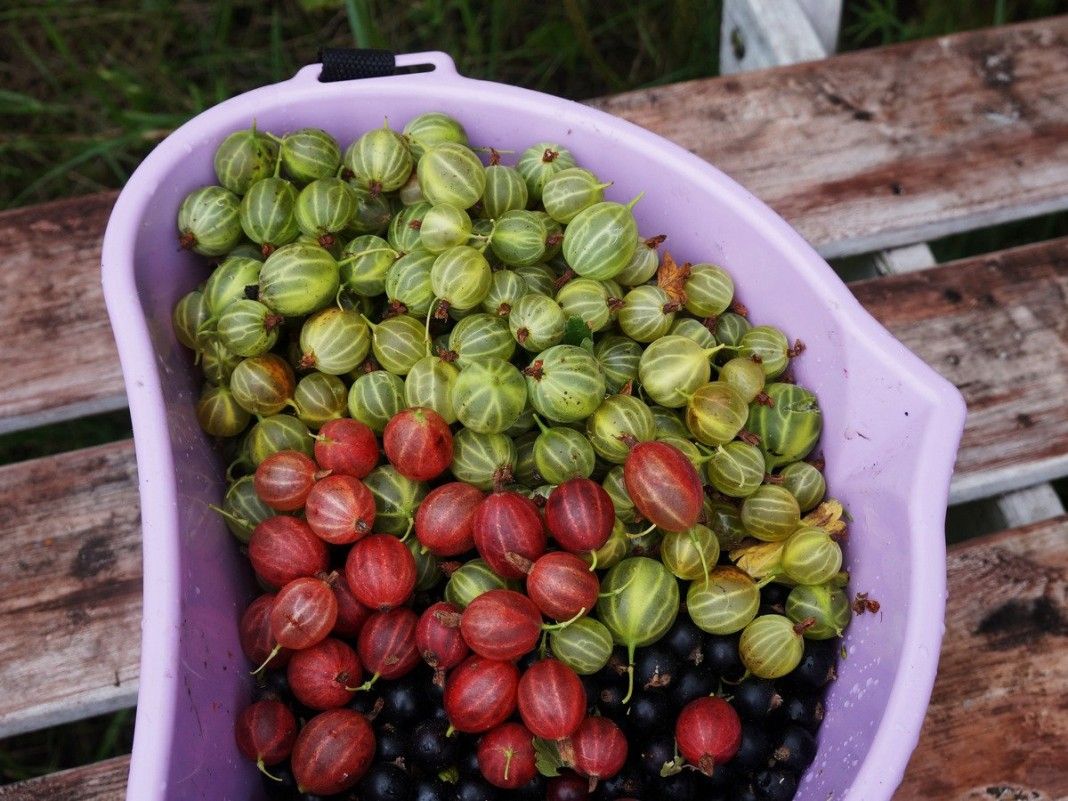Gooseberry is a bush consisting of many stems that reach one and a half meters in height. This plant begins to bear fruit in the 2-3rd year after planting, from the 5th -7th year the period of full fruiting begins. With proper care, gooseberry yield does not decrease for 30–40 years.
Content
Why cut gooseberries
A feature of this shrub is the ability to form many new branches annually. Without timely pruning, for several years the bush grows from 50 to 70 shoots of different ages. Such thickened gooseberries are often sick and give a small harvest of small berries.
Annual gooseberry shoots usually grow rapidly, this process continues until late autumn. Therefore, their tops do not have time to ripen by the end of the growing season and often freeze even in the southern regions of Russia, Belarus and Ukraine. Only the damaged areas of such shoots are removed, trying to preserve as many fruit buds as possible.
In the spring, you can clearly see which of the branches were damaged in winter, suffered from frost or sank to the ground under the weight of snow. Therefore, gooseberry pruning is carried out in very early spring, when the buds have not yet begun to open. During spring pruning, this shrub is removed:
- diseased and damaged branches;
- shoots thickening the bush;
- old branches that have reduced their yield.
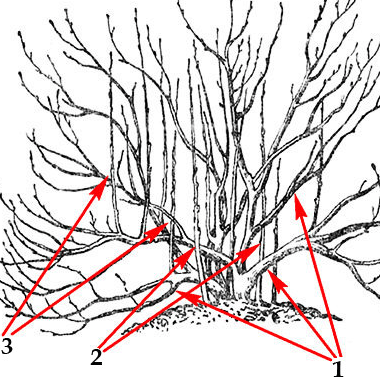
Gooseberry bush consists of basal branches of different ages: 1 - perennial skeletal (2-5 years), 2 - basal annuals, 3 - kidney annuals
Annual pruning of gooseberries makes it possible to maintain the bush in the most productive phase of development - not older than the critical age (7 years) for each breeding group (the best representatives of the variety) - and to constantly grow basal shoots, which replace the aged branches.
Gooseberry varieties
The basal branches of the gooseberry by the 4-7th year of life slow down the apical growth and reduce the yield. Such a spread in the timing of the slowdown in the intensive growth of the main axis of the basal branches is due to the biological characteristics of the gooseberry bred by breeders from different continents - the intensity of shoot formation and the durability of its fruits (short branches ending in a fruit bud). All varieties and hybrids of this fruit shrub are divided into 3 groups:
- European;
- American;
- European-American.
Varieties of European selection
European selection has always been aimed at increasing the size and mass of gooseberries. Charles Darwin, who himself bred 54 varieties of gooseberries, wrote about this in his diary:
“The most interesting aspect of gooseberry history is the constant increase in fruit ... The fruit of a wild gooseberry weighs about a quarter of an ounce, or 120 grains;
around 1786 a gooseberry weighing 240 grains * was displayed, that is, its weight doubled;
in 1817 the weight was 641 grains;
until 1825 there was no increase, but this year the figure was 760 grains;
in 1830 the Teazer weighed 781 grains;
in 1841 Wonderful 784 grains;
in 1844 London weighed 852 grains, and the following year 880 grains;
in 1852, in Steffordshire, the fruit of the same variety reached an astonishing weight of 896 grains, that is, seven and a half times the weight of the wild fruit. "
* 1 grain = 0.062 g. The fruit of a wild gooseberry weighs about 7.44 g, and the fruit of a varietal (for example, London variety) - 54.56 g.
The dark red berries of London gooseberries are still leading in size and weight. In England, the maximum weight of the berry is registered - 57.9 g. From one bush, from 4 to 6.2 kg of harvest are harvested.
Gooseberries of European selection, in addition to the size of the berries, are characterized by:
- not very high ability to shoot;
- long-term preservation of the productivity of basal branches - up to 7, or even up to 12 years;
- the formation of a crop on pods, which branch with age;
- significant thorns of branches - large thorns are located along their entire length;
- weak resistance to fungal diseases.
American varieties
American breeders have developed varieties that cannot boast of large berry sizes, but this is offset by their number. A prominent representative of this group is the Houghton variety - berries weighing up to 2 g, but the yield is up to 10 kg per bush.
American gooseberries are characterized by:
- high shoot-forming ability;
- fruiting on an annual growth - only a small part of the crop is formed on one-two-year-old fruits;
- rapid aging of basal branches - by the age of 5–6 they become bare and lose productivity;
- slight thorny branches;
- resistance to fungal diseases.
European-American group varieties
Gooseberry varieties obtained by crossing plants of European and American selection combine the biological characteristics of the bushes of both groups. An example of the gooseberry of the European-American group is the Russian variety (often called the Russian red), bred at the V.I. I. V. Michurin. The berries of this variety weigh up to 6 g, and the yield is from 4 to 10 kg per bush.
Gooseberry varieties of the European-American group are inherent in:
- high shoot-forming ability;
- maintaining the productivity of root branches from 6 to 8 years;
- the formation of fruits both on annual shoots (from 30 to 50%) and on one-two-year-old pods (from 50 to 70%);
- medium spikes - single thorns in the lower part of the shoot;
- resistance to fungal diseases.
Experienced gardeners, when purchasing gooseberry seedlings, are always interested in which breeding group the variety they have chosen belongs to. This gives them the opportunity to know in advance how intensive pruning of the bush will be required in the future and what the maximum (in terms of productivity) age of the branch will need to be removed.
Gooseberry bush formation
Already during planting, the formation of a gooseberry bush begins.
Primary pruning
The purchased seedling is cut immediately before planting. Dried roots are removed, and excessively long ones are shortened. If the seedling has one stem, then it is cut over the 4th to 6th bud, counting from the lowest one. The cut is made obliquely 0.5 cm above the kidney so as not to damage it.
If the seedling has two, three or more basal branches, then 2-3 strongest are left, and the rest are removed so that there are no stumps left. The remaining branches, which later become skeletal, are also cut over the 3-4th bud.
Video: how to plant gooseberries
Pruning a two year old bush
In the spring of next year, if the gooseberry was planted in the spring of the previous year, further formation of the bush is carried out. Shoots shading skeletal branches are removed at soil level.Leave 2-3 annual stems. All shoots are shortened, leaving 4–5 buds, from which branches will develop this year. Pay attention to the location of the buds on the branches. The bud over which the shoot will be cut should be directed outward of the bush. The branches will grow in the direction the buds are directed. The bush should have no more than 6-7 basal branches one and two years old.
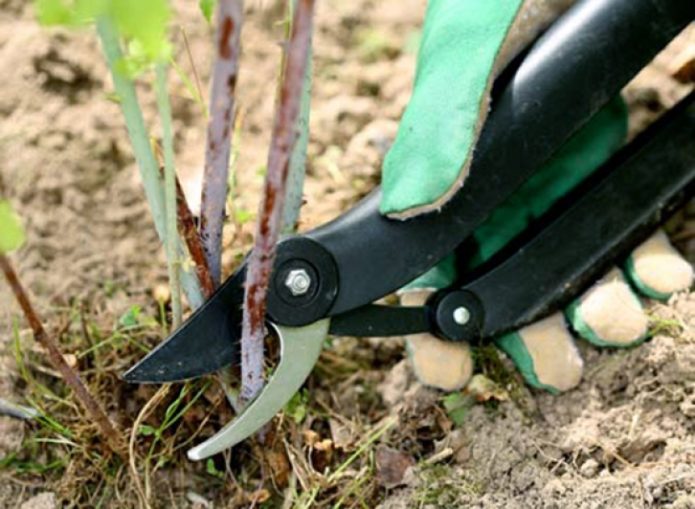
When pruning a two-year-old gooseberry bush, shoots are removed at soil level, shading the skeletal branches
Three year old gooseberry
Gooseberries begin to bear fruit 3-4 years after planting. The main fruiting is concentrated in the upper part of the shoots, and most of the fruit buds are laid on the annual growth of branches and young fruits. Therefore, starting from the third year of life of the gooseberry, after planting, its branches are not shortened - this will reduce the yield. An exception is made only for one-year growth that goes inside the bush and shades other branches.
Otherwise, the formation of the bush is as follows: the damaged branches and root growth of the last year are cut out, leaving 3-4 of the most powerful stems that do not thicken the middle of the bush. At the age of three, the bush should consist of 9–11 basal branches.
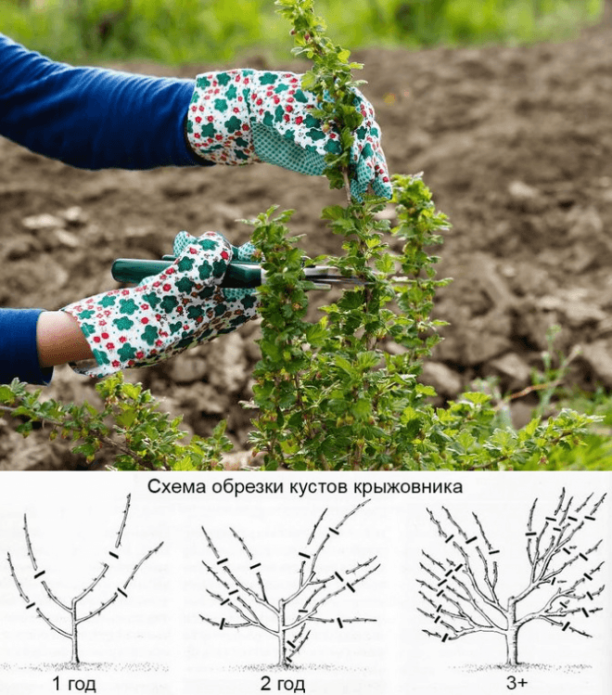
On the diagram of spring pruning of gooseberry bushes of different ages, parts of branches and annual shoots that need to be removed are marked
Adult gooseberry bush
The root branches of an adult gooseberry bush of different ages (4 years and older) cover an area of about 50 cm², and its crown - up to 1.5 m². After pruning old branches and excess annual shoots, 20-25 skeletal branches of all ages are left in the bush, if possible, the same amount for each age (2-4 shoots), with one or two more annuals, and one or two less for the oldest. two.
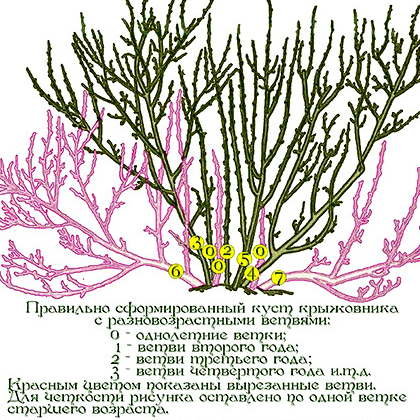
After pruning old branches (6, 7) and excess annual shoots (0), 20-25 skeletal branches of all ages are left in the bush
In the future, this operation is performed every year. Correctly pruned gooseberry bushes should consist of 20–25 basal branches - 4–5 branches of each age, from one-year to five-year shoots. Although the branches of European-bred gooseberries can bear fruit for up to 12 years, too many pathogens and pests accumulate in their bark. Experienced gardeners recommend cutting branches that are five years old every spring.
How to rejuvenate a gooseberry bush
The need for gooseberry rejuvenation arises for two reasons:
- poor growth on skeletal branches;
- the formation of the bush has not been carried out for several years.
Rejuvenating pruning, as well as formative pruning, is carried out in early spring, so that during the summer the bush has time to grow new shoots.
If the growth of annual stems on skeletal branches was very small, then these branches are rejuvenated. To do this, cut off the skeletal branch to the strongest one-year lateral shoot, so that new shoots with fruit buds are already formed on it. Removing a part of the branch will have a beneficial effect on the strength of growth and branching of the lateral shoot: it becomes a young extension of the skeletal branch.
A more complicated procedure is the rejuvenation of neglected gooseberries. It will take 3 years for such a bush to form properly:
- In the first year, no more than a third of the old branches and a one-year growth thickening the middle of the bush are cut out.
- In the second year, remove half of the remaining old branches, leave 3-4 one- and two-year shoots.
- In the third year, the remaining old branches are removed and again 3-4 stems are left at the age of 1 to 3 years.
In the future, the formation of gooseberries is carried out according to the generally accepted scheme, that is, by the fifth year of formation, a bush of 20-25 branches of different ages is obtained.
Spring pruning of gooseberries should be done annually. A properly formed bush will give consistently high yields of large (for this variety) and high-quality berries for 20-30 years.
